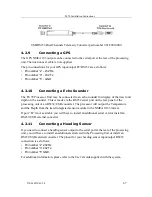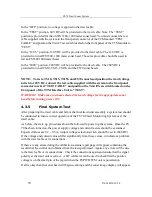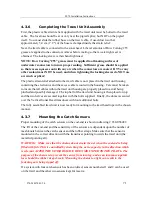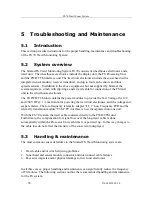
FS70 Trawl Sonar System
80
974-24007001/5.0
Note: The current meter will pulse each time the transmitter pings. The pulse will be at a
constant rate depending on your operating setting.
2.
Increase in Current:
Gradual increases in the trawl unit current may be due to either the trawl cable or the trawl
unit electronics. A higher cable closed loop resistance, due to cable damage, poor splices,
poor winch slip-rings or water ingress in the cable may reduce the voltage supplied to the
sonar head below the required minimum DC voltage. This will result in the sonar head
drawing more current. Alternatively there may be a problem in the sonar head that causes
additional current draw.
To diagnose this problem a current reading should be made with the system running on the
test cable. If this value is higher than a previous value obtained on the test cable or when
connected to the cable simulator then the problem is likely with the trawl unit electronics. If
the current readings are the same on test the cable as previously obtained, then the trawl
cable and winch slip-rings should be checked.
5.4.4
Trawl Cable Gain
By periodically checking the cable compensation gain obtained from the system unit and
comparing it to a previously recorded value the condition of the 3
rd
wire trawl cable can be
monitored. Acceptable cable gain values have less than “
10,
XXX” for the first gain
number. If the first gain value is over “
10,
XXX” then there may be a problem with the 3
rd
wire trawl cable and the system should be checked on the test cable. To facilitate
monitoring of the trawl cable, the cable gain values should be recorded on the test report.
5.4.5
Testing the Trawl Cable
If after testing the FS system the trawl cable is suspected to be faulty, then troubleshooting
is needed to determine what and where the problem is. For problems that are not obvious,
however, this can be quite difficult to do and may require someone experienced with testing
trawl cables. This following paragraph provides some basic tips in troubleshooting trawl
cables but is in no way a complete and comprehensive guide.
5.4.5.1
Trawl Cable Insulation Measurement
The use of a Mega-Ohmmeter to check the impedance of the trawl cable may be the most
useful test. It can be done with or without the slip-rings connected and readings should be
taken between the cable’s two conductors and also from each conductor to the fishing
vessels hull. Typically the impedance should be greater than 2 MΩ, and preferably over 6
MΩ and lower readings may be indicative of potential problems with the third wire cabling.
Summary of Contents for FS70 -
Page 2: ......
Page 3: ...974 24007001 5 0 I 974 24007001 5 0 FS70 Trawl Sonar System Operator manual...
Page 44: ...FS70 Trawl Sonar System 34 974 24007001 5 0 Click button on the recording tool bar...
Page 56: ...FS70 Trawl Sonar System 46 974 24007001 5 0 3 2 7 7 PI 40 kHz Channel Sensors Setup...
Page 103: ...974 24007001 5 0 93...
Page 104: ...FS70 Trawl Sonar System 94 974 24007001 5 0...
Page 105: ...974 24007001 5 0 95...
Page 106: ...FS70 Trawl Sonar System 96 974 24007001 5 0...
Page 107: ...974 24007001 5 0 97...
Page 108: ...FS70 Trawl Sonar System 98 974 24007001 5 0...
Page 109: ...974 24007001 5 0 99...
Page 110: ...FS70 Trawl Sonar System 100 974 24007001 5 0 This page is left intentionally blank...
Page 112: ...FS70 Trawl Sonar System 102 974 24007001 5 0 This page is left intentionally blank...
Page 113: ...2010 Kongsberg Mesotech...
Page 114: ...SIMRAD...
















































